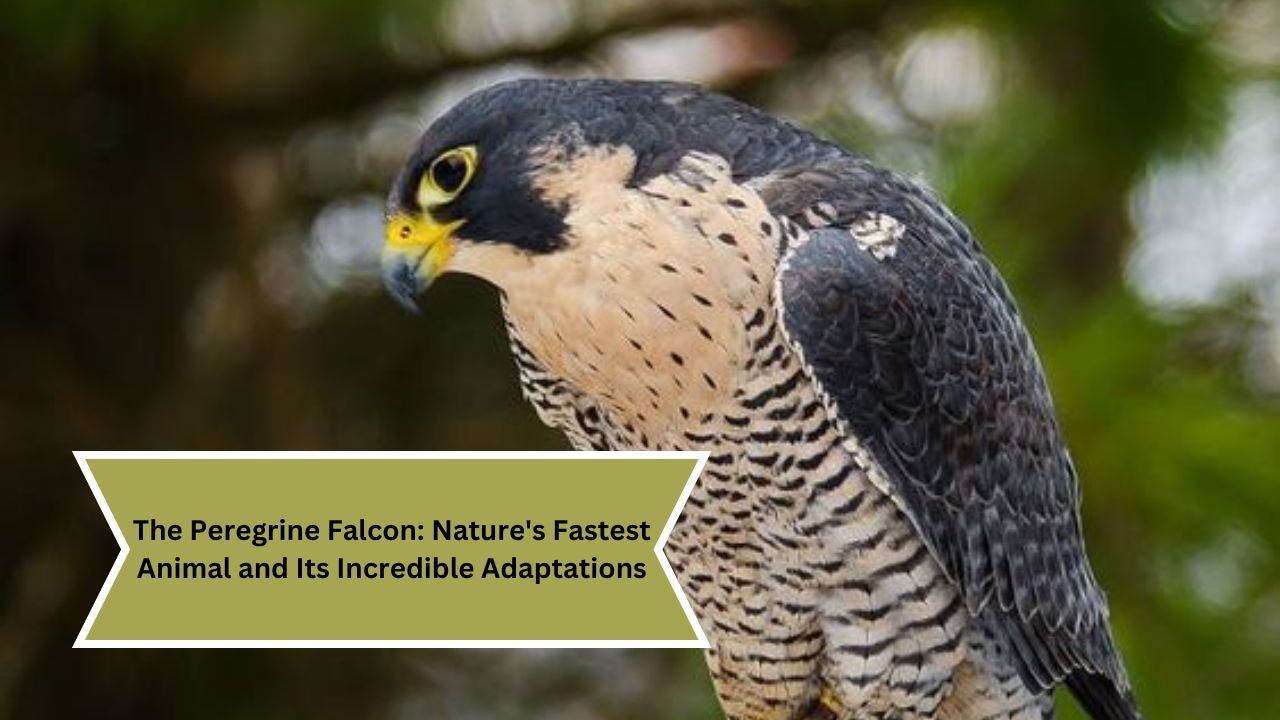The peregrine falcon (Falco peregrinus) holds the title of the fastest animal on the planet, reaching astonishing speeds that leave other creatures in the dust. Known for its remarkable hunting prowess, striking appearance, and incredible adaptations, this bird of prey has captured the admiration of wildlife enthusiasts and researchers alike. In this article, we will delve into the peregrine falcon’s physical characteristics, remarkable hunting techniques, adaptations for speed and agility, nesting behavior, conservation status, and its cultural significance across various societies.
Physical Characteristics
The peregrine falcon is a medium-sized raptor with a distinctive appearance. Adults typically measure between 15 to 20 inches in length, with a wingspan ranging from 3 to 4 feet. Their plumage varies by age and sex, but adults often display a bluish-gray back, white cheeks, and a distinctive black “moustache” marking, known as a malar stripe. The underparts are usually lighter with horizontal streaking.
One of the most fascinating aspects of the peregrine falcon is its sexual dimorphism. Females are generally larger than males, a trait common in many bird species of prey. This size difference plays a crucial role in hunting dynamics, as females often target larger prey, while males focus on smaller birds.
The Fastest Animal
The peregrine falcon is renowned for its incredible speed, especially during its hunting stoop (high-speed dive). When hunting, the falcon can reach speeds exceeding 240 miles per hour (386 kilometers per hour), making it the fastest animal on Earth. This remarkable speed allows the peregrine falcon to surprise and capture its prey with astonishing efficiency.
During a stoop, the peregrine falcon tucks its wings close to its body, reducing drag and maximizing aerodynamic efficiency. Its keen eyesight enables it to spot prey from great distances, and its sharp talons are perfectly adapted for seizing birds mid-flight. This unique combination of speed, agility, and precision makes the peregrine falcon an exceptional hunter.
Hunting Techniques
Peregrine falcons primarily feed on other birds, which they capture in mid-air. Their hunting strategy often involves perching high on cliffs or tall structures to scan the surrounding area for potential prey. Once they spot a target, they launch into a rapid dive, accelerating towards their unsuspecting victim.
The falcon’s incredible eyesight is one of its most valuable adaptations. It can see four to eight times better than humans, allowing it to detect prey from great distances. The peregrine falcon can also perceive ultraviolet light, giving it a unique advantage when hunting for certain species of birds.
Upon reaching a suitable altitude, the peregrine falcon will extend its wings and initiate its stoop, diving at an astonishing speed toward the prey. To strike the bird, the falcon uses its sharp talons to deliver a powerful blow, often stunning or killing the target instantly. This combination of speed, accuracy, and strength allows the peregrine falcon to thrive in various environments, from urban landscapes to remote wilderness areas.
Incredible Adaptations
The peregrine falcon possesses several remarkable adaptations that contribute to its status as a top predator. Its lightweight, aerodynamic body is perfectly designed for speed, with long, pointed wings that enable agile flight. The falcon’s muscular build allows for powerful takeoffs and sustained high-speed pursuits.
Another notable adaptation is its unique respiratory system. Peregrine falcons have specialized air sacs that allow for efficient oxygen exchange during flight. This adaptation enables them to maintain high levels of physical exertion while diving at incredible speeds. Additionally, the structure of their eyes includes a special nictitating membrane, a third eyelid that protects their eyes during high-speed dives while still allowing them to see clearly.
The peregrine falcon also has a specialized beak that features a notch, allowing it to sever the spinal cord of its prey with precision. This adaptation is crucial for quickly immobilizing captured birds, ensuring a successful hunt.
Nesting and Reproduction
Peregrine falcons are highly territorial during the breeding season, typically nesting on high cliffs, tall buildings, or other elevated structures. They often return to the same nesting site year after year, showcasing strong site fidelity. The nest itself is a simple scrape in the ground, usually lined with small stones or debris, providing a secure environment for their eggs.
The female peregrine lays a clutch of three to five eggs, which she incubates for about 30 to 32 days. During this time, the male provides food for the female and guards the nest site. Once the eggs hatch, the chicks are altricial, meaning they are born relatively helpless and require extensive care from both parents.
Peregrine falcon chicks are fed a diet primarily composed of fresh prey, which the parents catch and bring back to the nest. As they grow, the young falcons develop their flight feathers and begin exercising their wings. They fledge, or take their first flight, at about six to eight weeks of age, but they remain dependent on their parents for food and protection for several more weeks.
Conservation Status
Historically, the peregrine falcon faced significant threats due to habitat destruction, hunting, and the use of pesticides like DDT, which caused a drastic decline in populations during the mid-20th century. Conservation efforts began in the 1970s, focusing on banning harmful pesticides, protecting nesting sites, and reintroducing falcons to areas where they had been extirpated.
These efforts proved successful, and peregrine falcon populations have rebounded dramatically. As of today, the peregrine falcon is classified as a species of “Least Concern” by the International Union for Conservation of Nature (IUCN). Nevertheless, local populations may still face threats from habitat loss, pollution, and human interference.
Continued monitoring and conservation initiatives are crucial to ensuring the long-term survival of peregrine falcons and maintaining healthy populations across their range.
Cultural Significance
The peregrine falcon has played a significant role in various cultures throughout history. In many ancient civilizations, including the Egyptians and Native American tribes, the falcon was regarded as a symbol of power, freedom, and nobility. Its swift flight and predatory prowess inspired admiration and reverence.
In falconry, a traditional practice that dates back thousands of years, peregrine falcons are highly prized for their hunting abilities. Falconry involves training birds of prey to hunt game, and peregrines have been favored for their speed and agility. This ancient art has fostered a deep bond between humans and these magnificent birds, highlighting the importance of understanding and respecting wildlife.
Conclusion
The peregrine falcon stands as a testament to the incredible adaptations of nature’s creatures. Its remarkable speed, keen eyesight, and unparalleled hunting skills make it a true marvel of the avian world. As we continue to study and admire these magnificent birds, it is crucial to ensure their conservation and protect their habitats, allowing future generations to experience the wonder of the peregrine falcon in the wild. Whether soaring high above cliffs or diving through the sky in pursuit of prey, the peregrine falcon embodies the beauty and power of nature, reminding us of the delicate balance that exists within our ecosystems.
| HOME | CLICK HERE |
| PEREGRINE | CLICK HERE |

